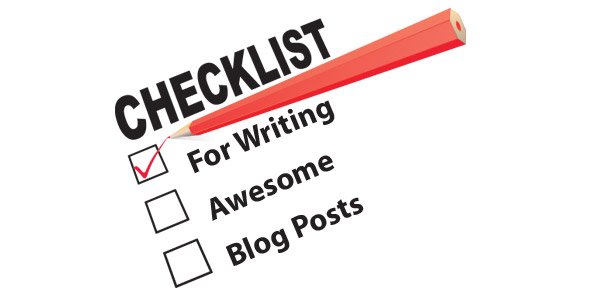Checklist for Writing Awesome Blog Posts

Every experienced blogger incorporates some method when compiling blog posts. They do this by following a basic set of guidelines moulded to their own unique situations and styles.
Blog Content vs. Mattresses
I usually compare blog content to the softness/support ratio a mattress needs to have. Imagine the mattress padding consisting of:
- Opinion pieces
- Weekly roundups
- Top ten posts
With the mattress springs consisting of:
- Research-based pieces
- Meaty posts
- Posts announcing new and important information
Different mattresses will suit different individuals, and so the correct ratio will also be required when writing and maintaining a successful blog. Here is a checklist which will help you write awesome and more in-depth blog posts
Checklist for Writing Awesome Blog Posts

Prepare Yourself
There are 7 steps to ensure adequate preparation:
1. Distinguish Yourself and Don’t Imitate
You only become a successful blogger by offering something unique to the viewer. Establish yourself by not imitating industry leaders.
2. Don’t Scrape for Crumbs
Don’t just post for the sake of posting. Great bloggers publish useful and informative posts when and as they see fit.
3. Know Your Audience
As the blogger, you share the same interest as your audience, therefore you should write as if writing for yourself. Will you pick your own blog to read amongst thousands of others? If not, you need to determine why.
4. Contribute by Providing Fresh Information
Readers want fresh, unique and useful information. If you are simply stating the obvious or restating what was already covered by others, chances are you won’t generate a following.
5. Do Proper Research & Be Creative
You don’t need the secret service to obtain new information. Instead, simply create it yourself! You can even use public data.
6. Think Like a Magazine Editor
Not all articles in a magazine may interest a reader, yet a couple of great ones ensure people subscribe to it. Make sure your blog includes both attention grabbing and deeper content posts.
7. Challenge Yourself & Stay motivated
Blogging is not only difficult at times, but can be both time consuming and disheartening. Your environment should be filled with people who support you both at home and online. Ultimately, your audience should become this influence.
Time to Write
Providing attention grabbing content is one thing, writing professionally is another. There is nothing more wretched than reading content with poor grammar and spelling. Your reputation is at stake, and if you can’t spell properly, how will people be convinced that your content is reliable? Ensure it is done correctly the first time.
1. Use a Word Processor
Draft your post in a Word processor such as Microsoft Word to ensure your spelling and grammar is correct. Never draft it straight into your web editor.
2. Note Your Main Ideas First
This will ensure you leave a comprehensive post containing all the important ideas.
3. Be Able to Backup Your Statements
Take ownership of your posts, and ensure that they are credible as you may one day need to back it up with facts.
4. Read Your Post Aloud
Obvious typos can time again be overlooked when silently reading your content. Any copywriter will tell you that this can be avoided when reading the same text aloud.
5. Have Adequate Layout to Keep Attention
Use bullet points, tables or images to separate large pieces of text to ensure that the attention of the reader remains fixed.
6. Take Some Time Out
Save your document and take a break for an hour or so. Not only does it give you a well deserved break, but also helps to clear your mind and allows you to scrutinise your document with a fresh approach.
7. Remove the BS
Read your post and edit where required. Look for unnecessary arguments, preaching, repetitious points and wordy sentences, and remove them.
8. Publish It
Again, read your post aloud. If you feel confident enough that you could read it to a live audience, you are ready to post it to your blog.
Start Blogging
Blogging is a wonderful tool and specifically designed to allow interaction between both the blogger and those viewing the posts. Successful blogging will require some maintenance. Do this by:
1. Becoming the Viewer
Access your blog as a viewer reading your post for the first time. Ensure that the post layout, spelling and grammar are correct, and that images display accurately. Check that the URL path of a link correctly displays and that it opens in a new window. Here you want to ensure all works 100% as you want to avoid people leaving your blog mid-post.
2. Respond to Comments
Blog posts are meant to be interactive, and without responding to questions, you will leave the impression that you are not serious about your blog. There is no rule stating you have to reply to every comment made, but be sure to contribute to your blog community with proper etiquette.
3. Add Updates
If you stand to be corrected after publishing a comment, always remember to provide updates. Never delete incorrect posts as people can always view cached versions of your post. People tend to relate more to bloggers who acknowledge mistakes and provide a solution. Use the strikethrough in these instances and ensure to make it obvious to the viewers.
4. Engage in Conversations on the Web
People might be talking about your post elsewhere on the web, so be sure to join in the conversation. Use the following book marking search engines to find these conversations:
- Google Blog Search.
- Delicious,
- Technorati.
- Reflect and Learn
This is probably one of the most important actions any blogger should take. After publishing your post, take some time to reflect on how well or poorly you have done.
- Have you achieved the desired results?
- Have you made any mistakes?
Determine the way forward, and if satisfied with your work, give yourself a well deserved pat on the back!
 5 Blogging Limiting Beliefs about Money that You Need to Release
5 Blogging Limiting Beliefs about Money that You Need to Release What’s Up Bloggers! Roundup #8 with Don Sturgill
What’s Up Bloggers! Roundup #8 with Don Sturgill What is Keeping Your Blog from Making Money?
What is Keeping Your Blog from Making Money? 10 Techniques how to Start a Blog Post to Engage Readers to Stay on Page
10 Techniques how to Start a Blog Post to Engage Readers to Stay on Page
{ 21 Responses }